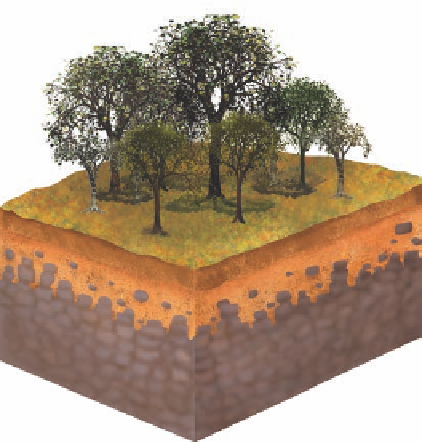Geoscience Reference
In-Depth Information
Soil-Forming Factors
Let's now examine the factors that generally influence soil
development. Five of these variables, traditionally called the
soil-forming factors
, consistently affect how soils evolve.
These factors are climate, organisms, relief, parent material,
and time; these variables can be remembered with the sim-
ple acronym
CLORPT
. Although you need to consider these
factors in every soil, their character and relative significance
vary considerably from a geographic perspective. In order to
understand the discussion of specific soil types presented later
in this chapter, you must first comprehend how soil-forming
factors influence soil development individually and collec-
tively. As you examine these variables, keep in mind that all
of them contribute to soil development in some way in each
and every soil.
affects the way in which additions, translocations, deple-
tions, and transformations occur.
In general, soils form in two very broad types of parent
material, residual and transported.
Residual parent material
is sediment that develops when underlying rock weathers
in
place
; in other words, it has not been moved from someplace
else. Such rock may be millions, or even hundreds of millions,
of years old. The concept of weathering will be discussed more
thoroughly in Chapter 14, but for now, think of it as the pro-
cess by which rock slowly breaks up into smaller fragments and
particles. This transformation takes place through chemical and
physical changes that are largely associated with water.
As this weathering occurs—in other words, as the
rock fragments become smaller and change their chemical
composition—a material called
regolith
begins to form. Fig-
ure 11.8 shows the relationship among bedrock, regolith, and
soil. Notice how the rocks in the upper part of the bedrock
break up into smaller pieces. Somewhere in this part of the
vertical sequence is a transition in which the bedrock is suf-
ficiently altered through weathering to be fundamentally dif-
ferent from the underlying (solid) rock from which it came.
At the same time, it has not been modified by additions and
translocations from above that occur in soil. In other words,
1.
Parent material
An important concept to consider in soil
science is that soils always form
within
sediment of some
kind. This sediment is referred to as
parent material
and
is closely related to the geology of the area in which a
particular soil forms. The character of the parent mate-
rial at any given locality is important in the context of
soils because it sets the stage for future development and
Trees, vegetation
Forest litter
(organic material)
Soil
Soil
Regolith
Regolith
(residual
parent
material)
Bedrock
Bedrock
(a)
(b)
Figure 11.8 Relationship of regolith to soil.
(a) Regolith consists of weathered bedrock that forms parent material in which soil forms.
(b) Limestone bedrock and overlying regolith in the Great Plains. Note how the size of rock fragments becomes progressively smaller above
the horizontal slab of solid rock. The soil is the dark zone at ground level.
Soil-forming factors
The variables of climate, organisms,
relief, parent material, and time that collectively influence the
development of soil.
Residual parent material
Parent material that forms by the
weathering of bedrock directly beneath it.
Regolith
The fragmented and weathered rock material that
overlies solid bedrock.
The mineral or organic material in which
Parent material
soil forms.








